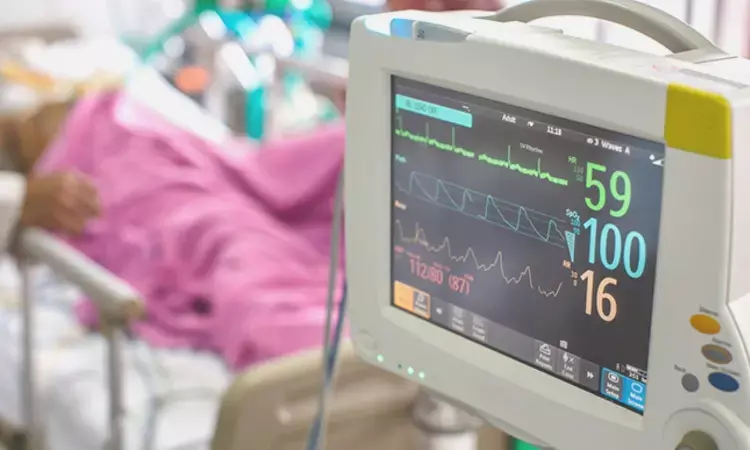- Home
- Medical news & Guidelines
- Anesthesiology
- Cardiology and CTVS
- Critical Care
- Dentistry
- Dermatology
- Diabetes and Endocrinology
- ENT
- Gastroenterology
- Medicine
- Nephrology
- Neurology
- Obstretics-Gynaecology
- Oncology
- Ophthalmology
- Orthopaedics
- Pediatrics-Neonatology
- Psychiatry
- Pulmonology
- Radiology
- Surgery
- Urology
- Laboratory Medicine
- Diet
- Nursing
- Paramedical
- Physiotherapy
- Health news
- Fact Check
- Bone Health Fact Check
- Brain Health Fact Check
- Cancer Related Fact Check
- Child Care Fact Check
- Dental and oral health fact check
- Diabetes and metabolic health fact check
- Diet and Nutrition Fact Check
- Eye and ENT Care Fact Check
- Fitness fact check
- Gut health fact check
- Heart health fact check
- Kidney health fact check
- Medical education fact check
- Men's health fact check
- Respiratory fact check
- Skin and hair care fact check
- Vaccine and Immunization fact check
- Women's health fact check
- AYUSH
- State News
- Andaman and Nicobar Islands
- Andhra Pradesh
- Arunachal Pradesh
- Assam
- Bihar
- Chandigarh
- Chattisgarh
- Dadra and Nagar Haveli
- Daman and Diu
- Delhi
- Goa
- Gujarat
- Haryana
- Himachal Pradesh
- Jammu & Kashmir
- Jharkhand
- Karnataka
- Kerala
- Ladakh
- Lakshadweep
- Madhya Pradesh
- Maharashtra
- Manipur
- Meghalaya
- Mizoram
- Nagaland
- Odisha
- Puducherry
- Punjab
- Rajasthan
- Sikkim
- Tamil Nadu
- Telangana
- Tripura
- Uttar Pradesh
- Uttrakhand
- West Bengal
- Medical Education
- Industry
Non-invasive ventilation beneficial for preoxygenation before general anesthesia: Study

Taiwan: For preoxygenation, non-invasive ventilation (NIV) appears to be more effective compared to the conventional methods, particularly in obese patients undergoing selective surgeries, a study in a recent issue of BMC Anesthesiology has stated.
Preoxygenation is essential for providing sufficient oxygen reservoir to a patient before intubation and allows the period between breathing termination and critical desaturation (safe apnoea time). Generally, face mask ventilation is used for preoxygenation. Non-invasive ventilation is a recently introduced method for preoxygenation. NIV settings include bilevel positive airway pressure, CPAP, and pressure support ventilation with or without positive end-expiratory pressure (PEEP).
Against the above background, Tsai-Lien Chiang, Taipei Medical University-Shuang Ho Hospital, Taiwan, and colleagues compared the outcomes of non-invasive ventilation and face mask ventilation for preoxygenation through a systemic review and meta-analysis.
For this purpose, the researchers searched the online databases for eligible studies published from database inception to September 2021. Randomized controlled trials comparing the outcomes of non-invasive or face mask ventilation for preoxygenation patients scheduled for surgeries met the inclusion criteria.
Safe apnea time was the primary outcome, and secondary outcomes included postoperative complications, minimal SpO2 during tracheal intubation, the proportion of patients who achieved the expired O2 fraction (FeO2) following 3 min of preoxygenation, partial pressure of carbon dioxide (PaCO2) after preoxygenation, partial pressure of oxygen in the arterial blood (PaO2), and PaO2 and PaCO2 after tracheal intubation. 13 trials met the inclusion criteria for inclusion in the study.
The study led to the following findings:
- The researchers observed significant differences in safe apnoea time, the number of patients who achieved FeO2 90% after preoxygenation for 3 min, and PaO2 and PaCO2 after preoxygenation and tracheal intubation.
- The non-obese subgroup observed no significant difference in safe apnoea time (mean difference: 125.38).
"The findings suggest that NIV is possibly more beneficial than conventional methods for preoxygenation, particularly in obese patients receiving selective surgeries," the authors wrote. "For non-obese patients, however, we suggest the need for further studies to assess whether NIV is superior to a conventional method."
"In some NIV groups, more gastric leakage and intolerance were observed, so the NIV's safety is a concern and may need further investigation."
To conclude, the results showed the possibility of NIV as a standard method of preoxygenation. Still, more studies are required to determine whether NIV is the better preoxygenation method or not.
Reference:
Chiang, TL., Tam, KW., Chen, JT. et al. Non-invasive ventilation for preoxygenation before general anesthesia: a systematic review and meta-analysis of randomized controlled trials. BMC Anesthesiol 22, 306 (2022). https://doi.org/10.1186/s12871-022-01842-y
Dr Kamal Kant Kohli-MBBS, DTCD- a chest specialist with more than 30 years of practice and a flair for writing clinical articles, Dr Kamal Kant Kohli joined Medical Dialogues as a Chief Editor of Medical News. Besides writing articles, as an editor, he proofreads and verifies all the medical content published on Medical Dialogues including those coming from journals, studies,medical conferences,guidelines etc. Email: drkohli@medicaldialogues.in. Contact no. 011-43720751


